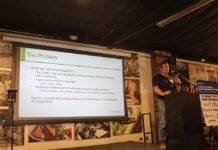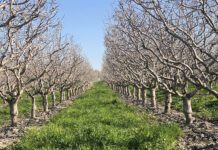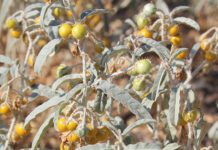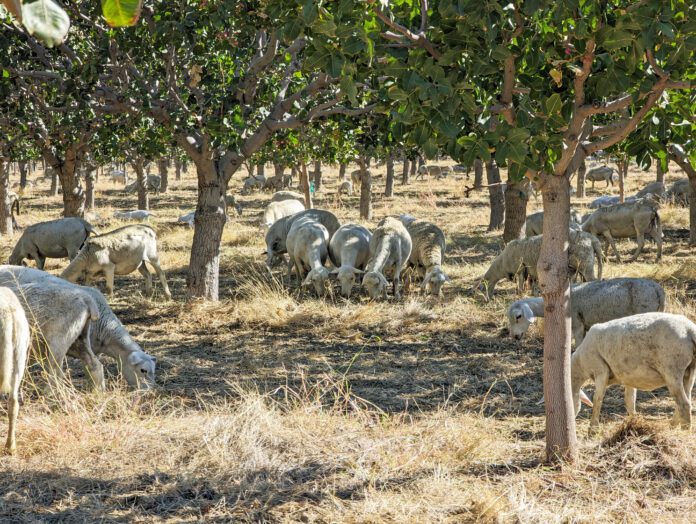
A small but increasing number of tree nut producers have enlisted sheep to graze cover crops, reduce mowing and herbicide costs, and recycle nutrients. Now a group of researchers believe the wooly weed eaters may also have a role in managing orchard floor mummy nuts and the pests that overwinter in them.
“I’m really excited about it because there’s such a potential for just about everybody to win,” said Houston Wilson, a UC Riverside associate CE specialist based at the UC Kearney Agricultural Research and Extension Center near Parlier. He is leading a study on the effects of sheep grazing on pistachio mummies on the ground.
Although not part of this study, Wilson also has seen sheep eat almond mummies on the ground.
For tree nut producers, using sheep may offer a more effective way to destroy ground mummies as they graze compared to mechanical flail chopping or grinding. This is particularly true with pistachios, which have a hard shell, making them more difficult to destroy. They also are smaller and can easily be mashed into orchard vegetation, protecting them from mechanical destruction.
As animals graze on orchard vegetation and possibly mummies, they also recycle nutrients back to the soil.
For sheep herders who typically pay to run their flock on winter alfalfa fields, having access to orchards could provide a potential new business opportunity.
Preliminary Results Look Encouraging
Although results of his initial study conducted during 2023-24 were encouraging, Wilson said several questions remain, such as animal stocking rate, grazing duration and an economic analysis. He hoped to answer at least some of those this season and winter.
Nevertheless, the initial results were promising enough that the California Pistachio Research Board, which helped fund the first year of research, renewed funding for 2024-25.
Stephen Vasquez, executive director of the California Pistachio Research Board, said they decided to underwrite Wilson’s project for a second year because it was “outside-the-box research.”
“Depending on the time of year, growers shake nuts, blow them into the middles, and that all takes money,” Vasquez said. “I think if you can eliminate one of those steps by shaking and bringing in animals to eat them, that could be a savings.”
Should Wilson answer the questions about the stocking rate, grazing duration and economics, Vasquez said grazing could become another tool at growers’ disposal to manage navel orangeworm (NOW).
Finding effective ways to address pests that overwinter in mummy nuts has taken on even more importance as the carpophilus beetle was recently found infecting pistachios and almonds and in one walnut orchard, Vasquez said. The pest overwinters in mummy nuts. Entomologists say they suspect the carpophilus beetle is now widespread throughout the San Joaquin Valley.
The results of Wilson’s initial study also led him to join a group of colleagues from UC and The Organic Center in a four-year $2 million study of livestock grazing in organic orchards. Funded by USDA’s Organic Agriculture Research and Extension Initiative, the project is titled “Influence of Orchard Grazing on Soil Health and Pest Control While Mitigating Food Safety Risk.”
Currently, the Food and Drug Administration requires animals be pulled from floor-harvested tree nut orchards at least 120 days before harvest to minimize risks from potential foodborne pathogens.
In the USDA-funded project, researchers will conduct trials in organic pistachio, almond and walnut orchards in two distinct growing regions of the state: the Sacramento Valley and the San Joaquin Valley. Wilson will head the pest management portion and examine grazing’s effects on orchard pests.
The researchers are currently mapping out how they will approach their trials and seeking cooperators with whom to partner. Field work will begin later this fall.
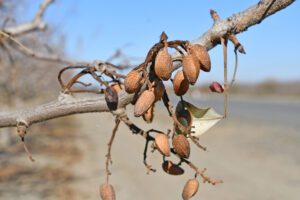
A Light Bulb Moment
For some time, Wilson had been looking for a mechanical way to better destroy mummies on the orchard floor than current methods. But he was never able to find an engineering solution that looked promising.
A recent producer survey conducted by UCCE Farm Advisor Phoebe Gordon about NOW management found weather was the main impediment to winter sanitation followed by labor availability and costs, and equipment.
Then a conversation with a PCA who was running sheep in a pistachio orchard led to a light bulb moment for Wilson.
“Listen, listen,” the PCA told him. “That’s the sound of sheep crunching mummies.’ It kind of dawned on me at that point. We may already have the perfect machine in a sheep or goat.”
Vasquez said pistachios likely lend themselves to sheep because they leaf out significantly later than almonds and on about the same schedule as walnuts. The longer leafless period would provide ample opportunity for the animals.
Putting Sheep to the Test
Wilson partnered with Research Entomologist Joel Siegel with the USDA Agricultural Research Service, a farm agronomy manager at a cooperating pistachio orchard and a PCA on a small-scale trial near Cantua Creek in west Fresno County.
It involved a 640-acre block of mature Golden Hills variety pistachios that was divided into 14-acre plots. From there, the researchers randomly selected 10 plots from which they sampled total pistachio mummies and biomass in 10 randomly selected points within each plot.
Then roughly 900 Dorper sheep were put in the block, allowed to graze for three days, and the vegetation and mummies resampled after the animals were removed.
The sheep did not appear to differentiate between filled and empty nuts, with both equally affected by grazing. The animals also readily consumed old nuts, some of which were moldy or rotten, as well as new nuts, Wilson said.
What the researchers found was the sheep don’t work like lawnmowers and instead grazed from the top of vegetation toward the ground.
In a heavily cover-cropped field, Wilson wondered whether the sheep would pick out the mummies, kind of like children pick out the marshmallow bits from a bowl of Lucky Charms. Based on conversations with the sheep herder, Wilson said the sheep don’t necessarily go after the mummies initially. Once a few animals find the tasty treats, others learn and follow suit.
Overall, Wilson found about a 25% reduction in mummy densities following sheep grazing. The sheep also reduced the vegetation biomass, suggesting the animals could contribute to both crop sanitation and weed management.
One question he said he hoped to answer this year was stocking rates, or the number of sheep per acre and the duration they’re allowed to graze.
“We’ve already seen when in some cases there were too many sheep and they ended up barking trees,” Wilson said.

Vicky Boyd | Contributing Writer
A veteran agricultural journalist, Vicky Boyd has covered the industry in California, Florida, Texas, Colorado, the South and the Mid-South. Along the way, she has won several writing awards. Boyd attended Colorado State University, where she earned a technical journalism degree with minors in agriculture and natural resources. Boyd is known for taking complex technical or scientific material and translating it so readers can use it on their farms. Her favorite topics are entomology, weeds and new technology. When she’s not out “playing in the dirt,” as she calls agricultural reporting, Boyd enjoys running, hiking, knitting and sewing.







